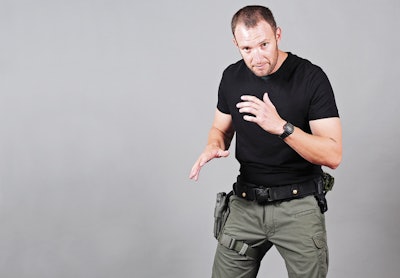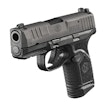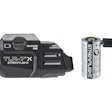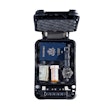 Photo: Mark W. Clark
Photo: Mark W. Clark
There are many options for safely carrying a handgun on your person, but in law enforcement training we tend to focus only on how to draw a full-size service pistol from a duty holster. If you are like most officers, you have spent hours on the square range drawing your duty gun from the holster on your belt. And that's very good. But many officers—perhaps even yourself—have hardly put any effort into training for how to draw from a holster position other than from the belt.
So let's look at some preferred techniques for drawing from a variety of concealed carry, off-duty, and special operation holsters.
On the Thigh
The preferred thigh holster draw does not differ at all from the one used to draw your duty weapon from your belt holster. This makes it easy for you to transition from wearing your gun on your belt to wearing it on your thigh.
But when you switch from a belt holster to a thigh rig, you have to make sure you have the thigh holster in the proper position. A thigh holster should be worn as high as possible on the leg so that the weapon clears any gear that you might be wearing. In addition, the strap should be firmly fitted to the leg to securely hold the weapon in place.
To check if your thigh holster is properly adjusted, stand tall with your arms down at your side. Now extend your primary hand and try to grab the bottom of the holster with all the fingers of your primary hand. If you can do that, then you are good to go.
A common error among thigh holster wearers is that they wear them too low around their knees. When a thigh rig is worn too low, it makes it difficult for the wearer to effectively draw and acquire a good sight picture. Fractions of seconds matter in a gunfight so proper adjustment and positioning of the thigh rig is crucial.
Inside-the-waistband (IWB) holsters have become one of the most popular holster options for officers who carry concealed off duty or while working plainclothes. But many of the officers who carry IWB holsters do not train adequately to draw from this position smoothly and effectively.
Drawing from an IWB can be entirely different than drawing from your duty holster. Points of consideration include: placement of the weapon on the body, retention systems of the holster, and the layers of clothing that might be covering the firearm. With these variables in mind, let's look at how to draw from an IWB, regardless of where it is located on your belt line.
The first priority is to clear the clothing that is concealing your weapon. (This step does not apply if the IWB is not concealed.) As your primary hand is reaching for the weapon, your support hand should simultaneously be grabbing the clothing that is closest to the weapon and getting the material out of the way. For example, if the weapon is located on the right side of your body, then you should not be pulling on the left side of your clothing.
From the Ankle
An ankle holster can be a very effective way to carry and conceal a handgun on your person. While there are several ways that an ankle holster can be placed, let's talk about drawing from the inside position of the support leg with your primary hand. So if you are right-handed the holster and weapon will be placed on the inside of the left leg.
When drawing from an ankle holster placed in the position noted above, your first movement will be to take a step forward with your left leg and place your right knee on the ground. Next you have to clear the pant leg that is covering the handgun. A common method used to clear the pant leg is to grab the lower part of the pant leg on either side with both hands and lift it. This will expose the weapon. Once you have exposed the handgun, you can establish a good firing grip with your primary hand, which allows for an effective draw. Because this method is so entirely different from drawing from a duty holster, it will require a lot of practice before you can become proficient.
Out of the Pocket
Pocket holsters have become extremely popular with civilians who have concealed carry licenses and want to carry subcompact pistols in a pants pocket. They are also popular with officers for backup, undercover, and off-duty carry.
Pocket holsters are deceptively simple, but they do have their issues. When drawing the handgun from the pocket, on occasion the holster will remain attached to the gun and will require the additional step of removing the holster from the gun once it has already been drawn.
Another issue is the speed with which the firearm can be drawn from the pocket. An illustration of this would be in the use of a pocket holster inside a pair of cargo shorts. Depending on the size of the handgun, it might be necessary to unbutton the pocket before it can be accessed, which could take additional time for the draw. Finally, re-holstering with one hand might be extremely difficult to do in a safe manner since the holster is essentially unsecured in the pocket.
But there are many positive aspects to using pocket holsters. They are designed to keep the shape of the intended pocket so that the handgun does not print its shape. In addition, the holster will keep the handgun from bouncing around in the pocket, which allows for comfort and consistency of weapon placement. Overall the pocket holster is an easy method of carrying a handgun on your person, which will increase your likelihood of carrying the firearm off duty.
Under the Arm
Drawing your weapon from a shoulder harness is a very different process than drawing from a duty holster. Safety is a primary concern with this draw because it's easy to point the muzzle at your support arm or at people behind you as you effect the draw.
To draw from a shoulder holster, reach across your body with your primary hand while at the same time lifting your support arm up so it is parallel with the ground and acquire a strong firing grip. Once the weapon has been removed from the holster and is pointing toward the intended target, lower your support arm and obtain a two-handed grip.
The shoulder holster is one of my favorite carry methods. It can carry a full-size handgun and is one of the more comfortable holsters to wear. It also offers excellent concealment under a sweatshirt, vest, or jacket.
Officer Daniel Greene is a former U.S Army helicopter pilot and a seven-year veteran of the Scottsdale (Ariz.) Police Department.
Related:












